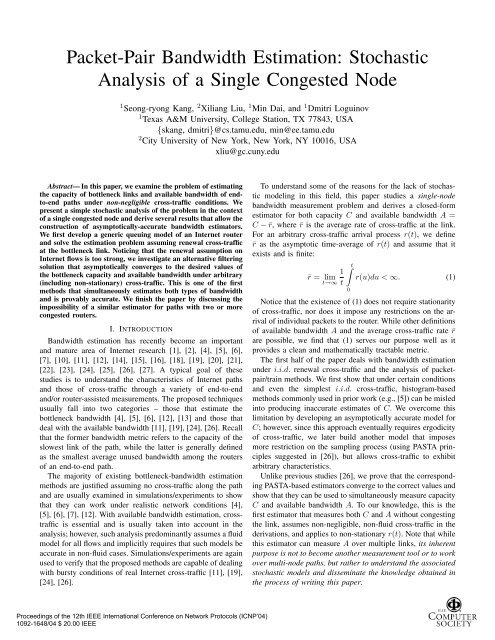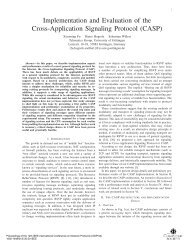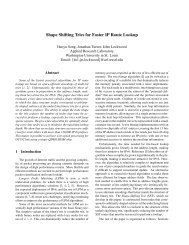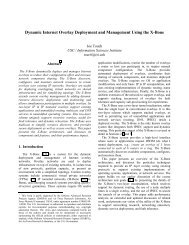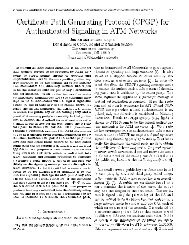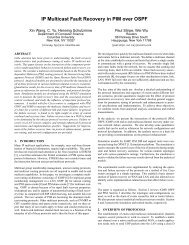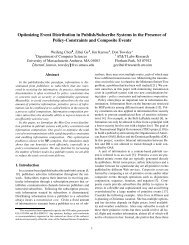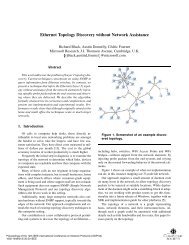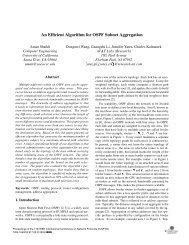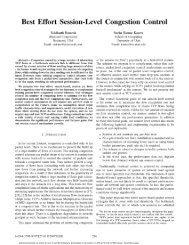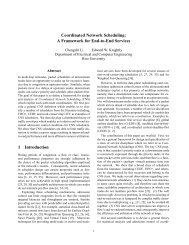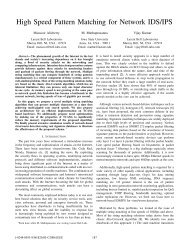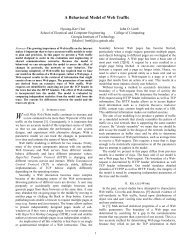Packet-pair bandwidth estimation: stochastic analysis of a ... - ICNP
Packet-pair bandwidth estimation: stochastic analysis of a ... - ICNP
Packet-pair bandwidth estimation: stochastic analysis of a ... - ICNP
Create successful ePaper yourself
Turn your PDF publications into a flip-book with our unique Google optimized e-Paper software.
<strong>Packet</strong>-Pair Bandwidth Estimation: Stochastic<br />
Analysis <strong>of</strong> a Single Congested Node<br />
1 Seong-ryong Kang, 2 Xiliang Liu, 1 Min Dai, and 1 Dmitri Loguinov<br />
1 Texas A&M University, College Station, TX 77843, USA<br />
{skang, dmitri}@cs.tamu.edu, min@ee.tamu.edu<br />
2 City University <strong>of</strong> New York, New York, NY 10016, USA<br />
xliu@gc.cuny.edu<br />
Abstract— In this paper, we examine the problem <strong>of</strong> estimating<br />
the capacity <strong>of</strong> bottleneck links and available <strong>bandwidth</strong> <strong>of</strong> endto-end<br />
paths under non-negligible cross-traffic conditions. We<br />
present a simple <strong>stochastic</strong> <strong>analysis</strong> <strong>of</strong> the problem in the context<br />
<strong>of</strong> a single congested node and derive several results that allow the<br />
construction <strong>of</strong> asymptotically-accurate <strong>bandwidth</strong> estimators.<br />
We first develop a generic queuing model <strong>of</strong> an Internet router<br />
and solve the <strong>estimation</strong> problem assuming renewal cross-traffic<br />
at the bottleneck link. Noticing that the renewal assumption on<br />
Internet flows is too strong, we investigate an alternative filtering<br />
solution that asymptotically converges to the desired values <strong>of</strong><br />
the bottleneck capacity and available <strong>bandwidth</strong> under arbitrary<br />
(including non-stationary) cross-traffic. This is one <strong>of</strong> the first<br />
methods that simultaneously estimates both types <strong>of</strong> <strong>bandwidth</strong><br />
and is provably accurate. We finish the paper by discussing the<br />
impossibility <strong>of</strong> a similar estimator for paths with two or more<br />
congested routers.<br />
I. INTRODUCTION<br />
Bandwidth <strong>estimation</strong> has recently become an important<br />
and mature area <strong>of</strong> Internet research [1], [2], [4], [5], [6],<br />
[7], [10], [11], [12], [14], [15], [16], [18], [19], [20], [21],<br />
[22], [23], [24], [25], [26], [27]. A typical goal <strong>of</strong> these<br />
studies is to understand the characteristics <strong>of</strong> Internet paths<br />
and those <strong>of</strong> cross-traffic through a variety <strong>of</strong> end-to-end<br />
and/or router-assisted measurements. The proposed techniques<br />
usually fall into two categories – those that estimate the<br />
bottleneck <strong>bandwidth</strong> [4], [5], [6], [12], [13] and those that<br />
deal with the available <strong>bandwidth</strong> [11], [19], [24], [26]. Recall<br />
that the former <strong>bandwidth</strong> metric refers to the capacity <strong>of</strong> the<br />
slowest link <strong>of</strong> the path, while the latter is generally defined<br />
as the smallest average unused <strong>bandwidth</strong> among the routers<br />
<strong>of</strong> an end-to-end path.<br />
The majority <strong>of</strong> existing bottleneck-<strong>bandwidth</strong> <strong>estimation</strong><br />
methods are justified assuming no cross-traffic along the path<br />
and are usually examined in simulations/experiments to show<br />
that they can work under realistic network conditions [4],<br />
[5], [6], [7], [12]. With available <strong>bandwidth</strong> <strong>estimation</strong>, crosstraffic<br />
is essential and is usually taken into account in the<br />
<strong>analysis</strong>; however, such <strong>analysis</strong> predominantly assumes a fluid<br />
model for all flows and implicitly requires that such models be<br />
accurate in non-fluid cases. Simulations/experiments are again<br />
used to verify that the proposed methods are capable <strong>of</strong> dealing<br />
with bursty conditions <strong>of</strong> real Internet cross-traffic [11], [19],<br />
[24], [26].<br />
To understand some <strong>of</strong> the reasons for the lack <strong>of</strong> <strong>stochastic</strong><br />
modeling in this field, this paper studies a single-node<br />
<strong>bandwidth</strong> measurement problem and derives a closed-form<br />
estimator for both capacity C and available <strong>bandwidth</strong> A =<br />
C − ¯r, where ¯r is the average rate <strong>of</strong> cross-traffic at the link.<br />
For an arbitrary cross-traffic arrival process r(t), we define<br />
¯r as the asymptotic time-average <strong>of</strong> r(t) and assume that it<br />
exists and is finite:<br />
∫<br />
1<br />
t<br />
¯r = lim r(u)du < ∞. (1)<br />
t→∞ t<br />
0<br />
Notice that the existence <strong>of</strong> (1) does not require stationarity<br />
<strong>of</strong> cross-traffic, nor does it impose any restrictions on the arrival<br />
<strong>of</strong> individual packets to the router. While other definitions<br />
<strong>of</strong> available <strong>bandwidth</strong> A and the average cross-traffic rate ¯r<br />
are possible, we find that (1) serves our purpose well as it<br />
provides a clean and mathematically tractable metric.<br />
The first half <strong>of</strong> the paper deals with <strong>bandwidth</strong> <strong>estimation</strong><br />
under i.i.d. renewal cross-traffic and the <strong>analysis</strong> <strong>of</strong> packet<strong>pair</strong>/train<br />
methods. We first show that under certain conditions<br />
and even the simplest i.i.d. cross-traffic, histogram-based<br />
methods commonly used in prior work (e.g., [5]) can be misled<br />
into producing inaccurate estimates <strong>of</strong> C. We overcome this<br />
limitation by developing an asymptotically accurate model for<br />
C; however, since this approach eventually requires ergodicity<br />
<strong>of</strong> cross-traffic, we later build another model that imposes<br />
more restriction on the sampling process (using PASTA principles<br />
suggested in [26]), but allows cross-traffic to exhibit<br />
arbitrary characteristics.<br />
Unlike previous studies [26], we prove that the corresponding<br />
PASTA-based estimators converge to the correct values and<br />
show that they can be used to simultaneously measure capacity<br />
C and available <strong>bandwidth</strong> A. To our knowledge, this is the<br />
first estimator that measures both C and A without congesting<br />
the link, assumes non-negligible, non-fluid cross-traffic in the<br />
derivations, and applies to non-stationary r(t). Note that while<br />
this estimator can measure A over multiple links, its inherent<br />
purpose is not to become another measurement tool or to work<br />
over multi-node paths, but rather to understand the associated<br />
<strong>stochastic</strong> models and disseminate the knowledge obtained in<br />
the process <strong>of</strong> writing this paper.<br />
Proceedings <strong>of</strong> the 12th IEEE International Conference on Network Protocols (<strong>ICNP</strong>’04)<br />
1092-1648/04 $ 20.00 IEEE
We conclude the paper by discussing the impossibility<br />
<strong>of</strong> building an asymptotically optimal estimator <strong>of</strong> both C<br />
and A for a two-node case. While <strong>estimation</strong> <strong>of</strong> A may<br />
be possible for multi-node paths, our results suggest that<br />
provably-convergent estimators <strong>of</strong> C do not exist in the context<br />
<strong>of</strong> end-to-end measurement. Thus, the problem <strong>of</strong> deriving a<br />
provably accurate estimator for a two-node case with arbitrary<br />
cross-traffic remains open; however, we hope that our initial<br />
work in this direction will stimulate additional research and<br />
prompt others to prove/disprove this conjecture.<br />
II. STOCHASTIC QUEUING MODEL<br />
In this section, we build a simple model <strong>of</strong> a router that<br />
introduces random delay noise into the measurements <strong>of</strong> the<br />
receiver and use it to study the performance <strong>of</strong> packet-<strong>pair</strong><br />
<strong>bandwidth</strong>-sampling techniques. Note that we depart from the<br />
common assumption <strong>of</strong> negligible and/or fluid cross-traffic and<br />
specifically aim to understand the effects <strong>of</strong> random queuing<br />
delays on the <strong>bandwidth</strong> sampling process. First consider an<br />
unloaded router with no cross-traffic. The packet-<strong>pair</strong> mechanism<br />
is based on an observation that if two packets arrive at the<br />
bottleneck link with spacing x smaller than the transmission<br />
delay ∆ <strong>of</strong> the second packet over the link, their spacing after<br />
the link will be exactly ∆. In practice, however, packets from<br />
other flows <strong>of</strong>ten queue between the two probe packets and<br />
increase their spacing on the exit from the bottleneck link to<br />
be larger than ∆.<br />
Assume that packets <strong>of</strong> the probe traffic arrive to the<br />
bottleneck router at times a 1 , a 2 ,...and that inter-arrival times<br />
a n − a n−1 are given by a random process x n determined by<br />
the server’s initial spacing. Further assume that the bottleneck<br />
node delays arriving packets by adding a random processing<br />
time ω n to each received packet n. For the remainder <strong>of</strong> the<br />
paper, we use constant 1 packet size q for the probing flow and<br />
arbitrarily-varying packet sizes for cross-traffic. Furthermore,<br />
there is no strict requirement on the initial spacing x n as long<br />
as the modeling assumptions below are satisfied. This means<br />
that both isolated packet <strong>pair</strong>s or bursty packet trains can be<br />
used to probe the path. Let the transmission delay <strong>of</strong> each<br />
application packet through the bottleneck link be q/C =∆,<br />
where C is the transmission capacity <strong>of</strong> the link. Under these<br />
assumptions, packet departure times d n are expressed by the<br />
following recurrence 2 :<br />
{<br />
a1 + ω 1 +∆ n =1<br />
d n =<br />
max(a n ,d n−1 )+ω n +∆ n ≥ 2 . (2)<br />
In this formula, the dependence <strong>of</strong> d n on departure time<br />
d n−1 is a consequence <strong>of</strong> FIFO queuing (i.e., packet n cannot<br />
depart before packet n − 1 is fully transmitted). Furthermore,<br />
packet n cannot start transmission until it has fully arrived<br />
(i.e., time a n ). The value <strong>of</strong> the noise term ω n is proportional<br />
to the number <strong>of</strong> packets generated by cross-traffic and queued<br />
1 Methods that vary the probing packet size also exist (e.g., [6], [10]).<br />
2 Times d n specify when the last bit <strong>of</strong> the packet leaves the router.<br />
Similarly, times a n specify when the last bit <strong>of</strong> the packet is fully received<br />
and the packet is ready for queuing.<br />
<br />
<br />
<br />
<br />
arrival <br />
departure <br />
<br />
time<br />
Fig. 1.<br />
<br />
<br />
Departure delays introduced by the node.<br />
in front <strong>of</strong> packet n. The final metric <strong>of</strong> interest is interdeparture<br />
delay y n = d n − d n−1 as the packets leave the<br />
router. The various variables and packet arrival/departure are<br />
schematically shown in Figure 1.<br />
Even though the model in (2) appears to be simple, it<br />
leads to fairly complicated distributions for y n if we make no<br />
prior assumptions about cross-traffic. We next examine several<br />
special cases and derive important asymptotic results about<br />
process y n .<br />
A. <strong>Packet</strong>-Pair Analysis<br />
III. RENEWAL CROSS-TRAFFIC<br />
We start our <strong>analysis</strong> with a rather common assumption in<br />
queuing theory that cross-traffic arrives into the bottleneck link<br />
according to some renewal process (i.e., delays between crosstraffic<br />
packets are i.i.d. random variables). In what follows<br />
in the next few subsections, we show that modeling <strong>of</strong> this<br />
direction requires stationarity (more specifically, ergodicity) <strong>of</strong><br />
cross-traffic. However, since neither the i.i.d. assumption nor<br />
stationarity holds for regular Internet traffic, we then apply<br />
a different sampling methodology and a different analytical<br />
direction to derive a provably robust estimator <strong>of</strong> capacity C<br />
and average cross-traffic rate ¯r.<br />
The goal <strong>of</strong> bottleneck <strong>bandwidth</strong> sampling techniques is to<br />
queue probe packets directly behind each other at the bottleneck<br />
link and ensure that spacing y n on the exit from the router<br />
is ∆. In practice, however, this is rarely possible when the<br />
rate <strong>of</strong> cross-traffic is non-negligible. This does present certain<br />
difficulties to the <strong>estimation</strong> process; however, assuming a<br />
single congested node, the problem is asymptotically tractable<br />
given certain mild conditions on cross-traffic. We present these<br />
results below.<br />
To generate measurements <strong>of</strong> the bottleneck capacity, it is<br />
commonly derived that the server must send its packets with<br />
initial spacing no more than ∆ (i.e., no slower than C). This is<br />
true for unloaded links; however, when cross-traffic is present,<br />
the probes may be sent arbitrarily slower as long as each<br />
packet i arrives to the router before the departure time <strong>of</strong><br />
packet i − 1. This condition translates into a n ≤ d n−1 and<br />
Proceedings <strong>of</strong> the 12th IEEE International Conference on Network Protocols (<strong>ICNP</strong>’04)<br />
1092-1648/04 $ 20.00 IEEE
(2) expands to:<br />
d n =<br />
{<br />
a1 + ω 1 +∆ n =1<br />
d n−1 + ω n +∆ n ≥ 2 . (3)<br />
From (3), packet inter-departure times y n after the bottleneck<br />
router are given by:<br />
y n = d n − d n−1 =∆+ω n , n ≥ 2. (4)<br />
Notice that random process ω n is defined by the arrival<br />
pattern <strong>of</strong> cross-traffic and also by its packet-size distribution.<br />
Since this process is a key factor that determines the distribution<br />
<strong>of</strong> sampled delays y n , we next focus on analyzing its<br />
properties. Assume that inter-packet delays <strong>of</strong> cross-traffic are<br />
given by independent random variables {X i } and the actual<br />
arrivals occur at times X 1 ,X 1 + X 2 ,... Thus, the arrival<br />
pattern <strong>of</strong> cross-traffic defines a renewal process M(t), which<br />
is the number <strong>of</strong> packet arrivals in the interval [0,t]. Using<br />
common convention, further assume that the mean inter-arrival<br />
delay E[X i ] is given by 1/λ, where λ =¯r is the mean arrival<br />
rate <strong>of</strong> cross-traffic in packets per second.<br />
To allow random packet sizes, assume that {S j },j =<br />
1, 2,...are independent random variables modeling the size <strong>of</strong><br />
packets in cross-traffic. We further assume that the bottleneck<br />
link is probed by a sequence <strong>of</strong> packet-<strong>pair</strong>s, in which the<br />
delay between the packets within each <strong>pair</strong> is small (so as<br />
to keep their rate higher than C) and the delay between the<br />
<strong>pair</strong>s is high (so as not to congest the link). Under these<br />
assumptions, the amount <strong>of</strong> cross-traffic data received by the<br />
bottleneck link between probe packets 2m − 1 and 2m (i.e.,<br />
in the interval (a 2m−1 ,a 2m ]) is given by a cumulative reward<br />
process:<br />
v n =<br />
M(a n)−M(a<br />
∑ n−1)<br />
j=1<br />
S j , n =2m, (5)<br />
where n represents the sequence number <strong>of</strong> the second packet<br />
in each <strong>pair</strong>. For now, we assume a general (not necessarily<br />
equilibrium) process M(t) and re-write (4) as:<br />
M(a n )−M(a<br />
∑ n−1 )<br />
y n =∆+ v S j<br />
n<br />
C =∆+ j=1<br />
, n =2m. (6)<br />
C<br />
Since classical renewal theory is mostly concerned with<br />
limiting distributions, y n by itself does not lead to any tractable<br />
results because the observation period <strong>of</strong> the process captured<br />
by each <strong>of</strong> y n is very small.<br />
Define a time-average process W n to be the average <strong>of</strong> {y i }<br />
up to time n:<br />
W n = 1 n∑<br />
y i . (7)<br />
n<br />
Then, we have the following result.<br />
Claim 1: Assuming ergodic cross-traffic, time-average process<br />
W n converges to:<br />
lim W n =∆+ λE[x n]E[S j ]<br />
=∆+E[ω n ], (8)<br />
n→∞ C<br />
i=1<br />
Snd1<br />
100 mb/s<br />
100 mb/s<br />
1.5 mb/s<br />
R 1<br />
R 2<br />
Snd2<br />
100 mb/s<br />
Fig. 2.<br />
100 mb/s<br />
Rcv1<br />
Rcv2<br />
Single-link simulation topology.<br />
where E[x n ] is the mean inter-probe delay <strong>of</strong> packet-<strong>pair</strong>s.<br />
Pro<strong>of</strong>: Process W n samples a much larger span <strong>of</strong><br />
M(t) and has a limiting distribution as we demonstrate below.<br />
Applying Wald’s equation to (6) [28]:<br />
E [y n ]=∆+ E[M(a n) − M(a n−1 )]E[S j ]<br />
. (9)<br />
C<br />
The last result holds since M(t) and S j are independent<br />
and M(a n ) − M(a n−1 ) is a stopping time for sequence<br />
{S j }. Equation (9) can be further simplified by noticing that<br />
E[M(t)] is the renewal function m(t):<br />
E [y n ]=∆+ (m(a n) − m(a n−1 ))E[S j ]<br />
. (10)<br />
C<br />
Assuming stationary cross-traffic, (10) expands to [28]:<br />
E [y n ]=∆+ λE[x n]E[S j ]<br />
. (11)<br />
C<br />
Finally, assuming ergodicity <strong>of</strong> cross-traffic (which implies<br />
that <strong>of</strong> process y n ), we can obtain (11) using a large number<br />
<strong>of</strong> packet <strong>pair</strong>s as the limit <strong>of</strong> W n in (7) as n →∞.<br />
Notice that the second term in (8) is strictly positive under<br />
the assumptions <strong>of</strong> this paper. This leads to an interesting<br />
observation that the filtering problem we are facing is quite<br />
challenging since the sampled process y n represents signal<br />
∆ corrupted by a non-zero-mean noise ω n . This is a drastic<br />
departure from the classical filter theory, which mostly deals<br />
with zero-mean additive noise. It is also interesting that the<br />
only way to make the noise zero-mean is to either send probe<br />
traffic with E[x n ]=0(i.e., infinitely fast) or to have no crosstraffic<br />
at the bottleneck link (i.e., λ =¯r =0). The former case<br />
is impossible since x n is always positive and the latter case is<br />
a simplification that we explicitly want to avoid in this work.<br />
We will present our <strong>analysis</strong> <strong>of</strong> packet-train probing shortly,<br />
but in the mean time, discuss several simulations to provide<br />
an intuitive explanation <strong>of</strong> the results obtained so far.<br />
B. Simulations<br />
Before we proceed to <strong>estimation</strong> <strong>of</strong> C, let us explain several<br />
observations made in previous work and put them in the<br />
context <strong>of</strong> our model in (6) and (8). For the simulations in this<br />
section, we used the ns2 network simulator with the topology<br />
shown in Fig. 2. In the figure, the source <strong>of</strong> probe packets<br />
Snd1 sends its data to receiver Rcv1 across two routers R 1<br />
and R 2 . The speed <strong>of</strong> all access links is 100 mb/s (delay 5 ms),<br />
Proceedings <strong>of</strong> the 12th IEEE International Conference on Network Protocols (<strong>ICNP</strong>’04)<br />
1092-1648/04 $ 20.00 IEEE
0.6<br />
0.5<br />
0.4<br />
0.3<br />
0.2<br />
0.15<br />
0.25<br />
0.2<br />
frequency<br />
0.4<br />
0.3<br />
frequency<br />
0.2<br />
frequency<br />
0.1<br />
frequency<br />
0.15<br />
0.1<br />
0.2<br />
0.1<br />
0.1<br />
0.05<br />
0.05<br />
0<br />
8 9 10 11 12 13 14 15<br />
values <strong>of</strong> y(n) (ms)<br />
0<br />
10 15 20 25<br />
values <strong>of</strong> y(n) (ms)<br />
0<br />
8 10 12 14 16 18 20<br />
values <strong>of</strong> y(n) (ms)<br />
0<br />
10 15 20<br />
values <strong>of</strong> y(n) (ms)<br />
(a) ¯r =1mb/s<br />
(b) ¯r =1.3 mb/s<br />
(a) ¯r = 750 kb/s<br />
(b) ¯r =1mb/s<br />
The histogram <strong>of</strong> measured inter-arrival times y n under CBR cross-<br />
Fig. 3.<br />
traffic.<br />
The histogram <strong>of</strong> measured inter-arrival times y n under TCP cross-<br />
Fig. 4.<br />
traffic.<br />
while the bottleneck link R 1 → R 2 has capacity C =1.5 mb/s<br />
and 20 ms delay. Note that there are five cross-traffic sources<br />
attached to Snd2.<br />
We next discuss simulation results obtained under UDP<br />
cross-traffic. In the first case, we initialize all five sources<br />
in Snd2 to be CBR streams, each transmitting at 200 kb/s<br />
(¯r =1mb/s total cross-traffic). Each CBR flow starts with<br />
a random initial delay to prevent synchronization with other<br />
flows and uses 500-byte packets. The probe flow at Snd1<br />
sends its data at an average rate <strong>of</strong> 500 kb/s for the probing<br />
duration, which results in 100% utilization <strong>of</strong> the bottleneck<br />
link. In the second case, we lower packet size <strong>of</strong> cross-traffic to<br />
300 bytes and increase its total rate to 1.3 mb/s to demonstrate<br />
more challenging scenarios when there is packet loss at the<br />
bottleneck.<br />
These simulation results are summarized in Fig. 3, which<br />
illustrates the distribution <strong>of</strong> the measured samples y n based<br />
on each <strong>pair</strong> <strong>of</strong> packets sent with spacing x n ≤ ∆ (the results<br />
exclude packet <strong>pair</strong>s that experienced loss). Given capacity<br />
C =1.5 mb/s and packet size q =1, 500 bytes, the value <strong>of</strong><br />
∆ is 8 ms. Fig. 3 shows that none <strong>of</strong> the samples are located<br />
at the correct value <strong>of</strong> 8 ms and that the mean <strong>of</strong> the sampled<br />
signal (i.e., W n ) has shifted to 11.7 ms for the first case and<br />
14.5 ms for the second one.<br />
Next, we employ TCP cross-traffic, which is generated<br />
by five FTP sources attached to Snd2. The TCP flows use<br />
different packet sizes <strong>of</strong> 540, 640, 840, 1,040, and 1,240 bytes,<br />
respectively. The histogram <strong>of</strong> y n for this case is shown in Fig.<br />
4 for two different average cross-traffic rates ¯r = 750 kb/s and<br />
¯r =1mb/s. As seen in the figure, even though some <strong>of</strong> the<br />
samples are located at 8 ms, the majority <strong>of</strong> the mass in the<br />
histogram (including the peak modes) are located at the values<br />
much higher than 8 ms.<br />
Recall from (8) that W n <strong>of</strong> the measured signal tends to<br />
∆+E[ω n ]. Under CBR cross-traffic, we can estimate the mean<br />
<strong>of</strong> the noise E[ω n ] to be approximately 11.7 − 8=3.7 ms in<br />
the first case and 14.5−8 =6.5 ms in the second one. The two<br />
naive estimates <strong>of</strong> C based on W n are ˜C = q/W n =1, 025<br />
kb/s and ˜C = 827 kb/s, respectively. Likewise, for the TCP<br />
case, the measured averages (i.e., 12.2 and 13.3 ms each) <strong>of</strong><br />
samples y n lead to incorrect naive estimates ˜C = 983 kb/s<br />
and ˜C = 902 kb/s, respectively.<br />
In order to understand how ˜C and the value <strong>of</strong> W n evolve,<br />
we run another simulation under 1 mb/s total TCP cross-traffic<br />
and plot the evolutions <strong>of</strong> the absolute error | ˜C−C| and that <strong>of</strong><br />
W n in Fig. 5. As Fig. 5(a) shows, the absolute error between<br />
C and ˜C converges to a certain value after 5,000 samples y n ,<br />
providing a rather poor estimate ˜C ≈ 1, 010 kb/s. Fig. 5(b)<br />
illustrates that W n in fact converges to ∆+E[ω n ], where the<br />
mean <strong>of</strong> the noise is W n − ∆ ≈ 11.9 − 8=3.9 ms.<br />
Previous work [1], [4], [5], [15], [22] focused on identifying<br />
the peaks (modes) in the histogram <strong>of</strong> the collected <strong>bandwidth</strong><br />
samples and used these peaks to estimate the <strong>bandwidth</strong>;<br />
however, as Figs. 3 and 4 show, this can be misleading when<br />
the distribution <strong>of</strong> the noise is not known a-priori. For example,<br />
the tallest peak on the right side <strong>of</strong> Fig. 3 is located at 13 ms<br />
( ˜C = 923 kb/s), which is only a slightly better estimate than<br />
827 kb/s derived from the mean <strong>of</strong> y n . Moreover, the tallest<br />
peak in Fig. 4(a) is located at 14.5 ms, which leads to a worse<br />
estimate ˜C = 827 kb/s compared to 983 kb/s computed from<br />
the mean <strong>of</strong> y n .<br />
To combat these problems, existing studies [1], [4], [5], [15],<br />
[22] apply numerous empirical methods to find out which<br />
mode is more likely to be correct. This may be the only<br />
feasible solution in multi-hop networks; however, one must<br />
keep in mind that it is possible that none <strong>of</strong> the modes in the<br />
measured histogram corresponds to ∆ as evidenced by both<br />
graphs in Fig. 3.<br />
C. <strong>Packet</strong>-Train Analysis<br />
Another topic <strong>of</strong> debate in prior work was whether packettrain<br />
methods <strong>of</strong>fer any benefits over packet-<strong>pair</strong> methods.<br />
Some studies suggested that packet-train measurements converge<br />
to the available <strong>bandwidth</strong> 3 for sufficiently long bursts<br />
<strong>of</strong> packets [1], [4]; however, no analytical evidence to this<br />
effect has been presented so far. Other studies [5] employed<br />
packet-train estimates to increase the measurement accuracy<br />
<strong>of</strong> bottleneck <strong>bandwidth</strong> <strong>estimation</strong>, but it is not clear how<br />
these samples benefit asymptotic convergence <strong>of</strong> the <strong>estimation</strong><br />
process.<br />
We consider a hypothetic packet-train method that transmits<br />
probe traffic in bursts <strong>of</strong> k packets and averages the interpacket<br />
arrival delays within each burst to obtain individual<br />
3 Even though this question appears to have been settled in some <strong>of</strong> the<br />
recent papers, we provide additional insight into this issue.<br />
Proceedings <strong>of</strong> the 12th IEEE International Conference on Network Protocols (<strong>ICNP</strong>’04)<br />
1092-1648/04 $ 20.00 IEEE
Absolute error (kb/s)<br />
495<br />
490<br />
485<br />
480<br />
Average sample values (ms)<br />
11.95<br />
11.9<br />
11.85<br />
11.8<br />
11.75<br />
frequency<br />
0.4<br />
0.3<br />
0.2<br />
0.1<br />
frequency<br />
0.5<br />
0.4<br />
0.3<br />
0.2<br />
0.1<br />
0 1 2 3<br />
Number <strong>of</strong> samples<br />
x10 4<br />
0 1 2 3<br />
Number <strong>of</strong> samples<br />
x10 4<br />
0<br />
10 15 20 25<br />
values <strong>of</strong> y(n) (ms)<br />
0<br />
10 15 20 25<br />
values <strong>of</strong> y(n) (ms)<br />
(a) | ˜C − C|<br />
(b) W n<br />
(a) k =5<br />
(b) k =10<br />
Fig. 5. (a) The absolute error <strong>of</strong> the packet-<strong>pair</strong> estimate under TCP crosstraffic<br />
<strong>of</strong> ¯r =1mb/s. (b) Evolution <strong>of</strong> W n.<br />
Fig. 6. The histogram <strong>of</strong> measured inter-arrival times Zn k based on packet<br />
trains and CBR cross-traffic <strong>of</strong> ¯r =1.3 mb/s.<br />
samples {Zn}, k where n is the burst number. For example, if<br />
k =10, samples y 2 ,...,y 10 define Z1 10 , samples y 12 ,...,y 20<br />
define Z2 10 , and so on. The reason for excluding samples<br />
y 1 ,y n+1 ,...,y nk+1 is because they are based on the leading<br />
packets <strong>of</strong> each burst, which encounter large inter-burst gaps<br />
in front <strong>of</strong> them and do not follow the model developed so<br />
far.<br />
In what follows in this section, we derive the distribution<br />
<strong>of</strong> {Zn} k as k →∞.<br />
Claim 2: For sufficiently large k, constant x n = x, and a<br />
regenerative processes M(t), packet-train samples converge to<br />
the following Gaussian distribution for large n:<br />
{<br />
Z<br />
k<br />
n<br />
} D<br />
−→ N<br />
(<br />
, λxV ar[S j − λE[S j ]X i ]<br />
)<br />
(k − 1)C 2 ,<br />
∆+ λxE[S j]<br />
C<br />
(12)<br />
where −→ D<br />
denotes convergence in distribution, N(µ, σ) is a<br />
Gaussian distribution with mean µ and standard deviation σ,<br />
and X i are inter-packet arrival delays <strong>of</strong> cross-traffic.<br />
Pro<strong>of</strong>: First, define a k-sample version <strong>of</strong> the cumulative<br />
reward process in (5):<br />
V k n =<br />
M(a kn )−M(a k(n−1)+1 )<br />
∑<br />
j=1<br />
S j , n =1, 2,.... (13)<br />
Process Vn<br />
k is also a counting process, however, its timescale<br />
is measured in bursts instead <strong>of</strong> packets. Thus, Vn<br />
k<br />
determines the amount <strong>of</strong> cross-traffic data received by the<br />
bottleneck link during an entire burst n. Equation (13) shows<br />
that Zn k can be asymptotically interpreted as the reward rate<br />
<strong>of</strong> the reward-renewal process Vn k :<br />
Z k n =∆+<br />
V k n<br />
(k − 1)C , (14)<br />
where k − 1 is the number <strong>of</strong> inter-packet gaps in a k-packet<br />
train <strong>of</strong> probe packets. Assuming M(t) is regenerative and for<br />
sufficiently large k, we have [28]:<br />
Z k n =∆+<br />
V1<br />
k<br />
+ o(1). (15)<br />
(k − 1)C<br />
Applying the regenerative central limit theorem, constraining<br />
the rest <strong>of</strong> the derivations in this section to constant<br />
x n = x, and assuming E[X i ] < ∞ [28]:<br />
{ } V<br />
k (<br />
1 D<br />
−→ N<br />
k − 1<br />
λxE[S j ], λxV ar[S j − λE[S j ]X i ]<br />
k − 1<br />
(16)<br />
Combining (15) and (16), we get (12).<br />
First, notice that the mean <strong>of</strong> this distribution is the same<br />
as that <strong>of</strong> samples {y n } in (11), which, as was intuitively<br />
expected, means that both measurement methods have the<br />
same expectation. Second, it is also easy to notice that the<br />
variance <strong>of</strong> Zn k tends to zero as long as Var[X i ] is finite.<br />
Claim 3: If Var[X i ] is finite, the variance <strong>of</strong> packet-train<br />
samples Zn k tends to zero for large k.<br />
Pro<strong>of</strong>: Since λ, x, and E[S j ] are all finite and do not<br />
depend on k, using independence <strong>of</strong> S j and X i in (12), we<br />
have:<br />
( λxV<br />
Var[Zn]=<br />
k ar[Sj ]+λ 3 xE 2 ) 2<br />
[S j ]Var[X i ]<br />
(k − 1)C 2 , (17)<br />
which tends to 0 for k →∞.<br />
As a result <strong>of</strong> this phenomenon, longer packet trains will<br />
produce narrower distributions centered at ∆+E[ω n ]. The<br />
CBR case already studied in Fig. 3(b) clearly has finite<br />
Var[X i ] and therefore samples {Zn} k must exhibit decaying<br />
variance as k increases. One example <strong>of</strong> this convergence for<br />
packet trains with k =5and k =10is shown in Fig. 6.<br />
D. Discussion<br />
Now we address several observations <strong>of</strong> previous work.<br />
It is noted in [5] that while packet-<strong>pair</strong> histograms usually<br />
have many different modes, the histogram <strong>of</strong> packet-train<br />
samples becomes unimodal with increased k. This readily<br />
follows from (12) and the Gaussian shape <strong>of</strong> {Zn}. k Previous<br />
papers also noted (e.g., [5]) that as packet-train size k is<br />
increased, the distribution <strong>of</strong> samples {Zn} k exhibits lower<br />
variance. This result follows from the above discussion and<br />
(17). Furthermore, [5] found that packet-train histograms for<br />
large k tend to a single mode whose location is “independent<br />
<strong>of</strong> burst size k.” Our derivations provide an insight into how<br />
this process happens and shows the location <strong>of</strong> this “single<br />
mode” to be ∆+E[ω n ] in (12).<br />
In summary, packet-train samples {Zn} k represent a limited<br />
reward rate that asymptotically converges to a Gaussian distribution<br />
with mean E[y n ]. Perhaps it is possible to infer some<br />
)<br />
.<br />
Proceedings <strong>of</strong> the 12th IEEE International Conference on Network Protocols (<strong>ICNP</strong>’04)<br />
1092-1648/04 $ 20.00 IEEE
characteristics <strong>of</strong> {X i } by observing the variance <strong>of</strong> {Z k n} and<br />
applying the result in (12); however, since there are several<br />
unknown parameters in the formula (such as Var[X i ] and<br />
E[S j ]), this direction does not lead to any tractable results<br />
unless we assume a particular process M(t).<br />
Since {Z k n} asymptotically tend to a very narrow Gaussian<br />
distribution centered at ∆+E[ω n ], we find that there is no<br />
evidence that {Z k n} measure the available <strong>bandwidth</strong> or <strong>of</strong>fer<br />
any additional information about the value <strong>of</strong> ∆ as compared<br />
to traditional packet-<strong>pair</strong> samples {y n }.<br />
IV. ARBITRARY CROSS-TRAFFIC<br />
In this section, we relax the stationarity and renewal assumptions<br />
about cross-traffic and derive a robust estimator <strong>of</strong><br />
C and ¯r. Assume an arbitrary arrival process r(t) for crosstraffic,<br />
where r(t) is its instantaneous rate at time t. We impose<br />
only one constraint on this process – it must have a finite time<br />
average ¯r shown in (1). The goal <strong>of</strong> the sampling process<br />
is to determine both C and ¯r. Since ¯r >Cimply constant<br />
packet loss and zero available <strong>bandwidth</strong>, we are generally<br />
interested in non-trivial cases <strong>of</strong> ¯r ≤ C. Stochastic process<br />
r(t) may be renewal, regenerative, a superposition <strong>of</strong> ON/OFF<br />
sources, self-similar, or otherwise. Furthermore, since packet<br />
arrival patterns in the current Internet commonly exhibit nonstationarity<br />
(due to day-night cycles, routing changes, link<br />
failure, etc.), our assumptions on r(t) allow us to model a<br />
wide variety <strong>of</strong> such non-stationary processes and are much<br />
broader than commonly assumed in traffic modeling literature.<br />
Next, notice that if the probing traffic can sample r(t) using<br />
a Poisson sequence <strong>of</strong> probes at times t 1 ,t 2 ,..., the average<br />
<strong>of</strong> r(t i ) converges to ¯r (applying the PASTA principle [28]):<br />
∫<br />
r(t 1 )+r(t 2 )+... + r(t n ) 1<br />
t<br />
lim<br />
= lim r(u)du =¯r,<br />
n→∞<br />
n<br />
t→∞ t<br />
0<br />
(18)<br />
as long as delays τ i = t i − t i−1 are i.i.d. exponential random<br />
variables. In order to accomplish this type <strong>of</strong> sampling, the<br />
sender must emit packet-<strong>pair</strong>s at exponentially distributed<br />
intervals. Assuming that the i-th packet-<strong>pair</strong> arrives to the<br />
router at time t i , it will sample a small segment <strong>of</strong> r(t) by<br />
allowing g i amount <strong>of</strong> data to be queued between the probes:<br />
g i =<br />
t∫<br />
i +x i<br />
t i<br />
r(u)du ≈ r(t i )x i , (19)<br />
where x i is the spacing between the packets in the i-th packet<strong>pair</strong>.<br />
Again, assuming that y i is the i-th inter-arrival sample<br />
generated by the receiver, we have:<br />
y i =∆+ g i<br />
C =∆+r(t i)x i<br />
C . (20)<br />
Finally, fixing the value <strong>of</strong> x i = x, notice that W n has a<br />
well-defined limit:<br />
lim W 1<br />
n = lim<br />
n→∞ n→∞ n<br />
n∑<br />
i=1<br />
= ∆+ x C lim<br />
(<br />
∆+ r(t )<br />
i)x i<br />
C<br />
n∑<br />
n→∞<br />
i=1<br />
r(t i )<br />
n<br />
=∆+x¯r<br />
C . (21)<br />
In essence, this result 4 is similar to our earlier derivations,<br />
except that (21) requires much weaker restrictions on crosstraffic<br />
and also shows that a single-node model is completely<br />
tractable in the setting <strong>of</strong> almost arbitrary cross-traffic. We<br />
next show how to extract both C and ¯r from (21).<br />
A. Capacity<br />
Observe that (21) is a linear function <strong>of</strong> x, where ¯r is the<br />
slope and ∆ is the intercept 5 . Therefore, by injecting packet<strong>pair</strong>s<br />
with two different spacings x a and x b , one can compute<br />
the unknown terms in (21) using two sets <strong>of</strong> measurements<br />
{yi a} and {yb i }. To accomplish this, define the corresponding<br />
average processes to be Wn a and Wn:<br />
b<br />
Wn a = 1 n∑<br />
yi a , Wn b = 1 n∑<br />
yi b . (22)<br />
n<br />
n<br />
i=1<br />
The simplest way to obtain both Wn a and Wn b using a<br />
single measurement is to alternate spacing x a and x b while<br />
preserving the PASTA sampling property. Using a one-bit<br />
header field, the receiver can unambiguously sort the interarrival<br />
delays into two sets {yi a} and {yb i }, and thus compute<br />
their averages in (22).<br />
While samples are being collected, the receiver has two<br />
running averages produced by (22). Subtracting Wn b from Wn a ,<br />
we are able to separate ¯r/C from ∆:<br />
i=1<br />
lim (W n a − Wn)= b (x a − x b )¯r<br />
. (23)<br />
n→∞ C<br />
Next, denote by ˜∆ n the following estimate <strong>of</strong> ∆ at time n:<br />
˜∆ n = Wn a Wn a − Wn<br />
b − x a . (24)<br />
x a − x b<br />
Taking the limit <strong>of</strong> (24), we have the following result.<br />
Claim 4: Assuming a single congested bottleneck for which<br />
time-average rate ¯r exists, ˜∆n converges to ∆:<br />
lim ˜∆ n =∆. (25)<br />
n→∞<br />
Pro<strong>of</strong>: Re-writing (25):<br />
lim ˜∆ n =∆+ x a¯r<br />
n→∞<br />
C<br />
− x (x a − x b )¯r<br />
a<br />
=∆, (26)<br />
C(x a − x b )<br />
which is obtained with the help <strong>of</strong> (21), (23), and (24).<br />
Our next result shows a more friendly restatement <strong>of</strong> the<br />
previous claim.<br />
4 A similar formula has been derived in [3], [8], [19] and several other<br />
papers under a fluid assumption.<br />
5 For technical differences between this approach and previous work (such<br />
as TOPP [19]), see [17].<br />
Proceedings <strong>of</strong> the 12th IEEE International Conference on Network Protocols (<strong>ICNP</strong>’04)<br />
1092-1648/04 $ 20.00 IEEE
TABLE I<br />
AVAILABLE BANDWIDTH ESTIMATION ERROR<br />
Bottleneck capacity<br />
Relative error<br />
C (mb/s) Model (29) Pathload Spruce IGI<br />
1.5 8.6% 46.5% 27.9% 84.5%<br />
5 8.3% 40.1% 23.4% 90.0%<br />
10 10.1% 40.9% 26.9% 89.0%<br />
15 7.7% 38.5% 24.5% 83.1%<br />
Corollary 1: Assuming a single congested bottleneck for<br />
which time-average rate ¯r exists, estimate ˜C n = q/ ˜∆ n<br />
converges to capacity C:<br />
lim ˜C n = lim<br />
n→∞<br />
n→∞<br />
B. Available Bandwidth<br />
= lim<br />
n→∞<br />
q<br />
Wn a Wn − x a−W n<br />
b a x a−x b<br />
q(x a − x b )<br />
x a W b n − x b W a n<br />
= C. (27)<br />
Notice that knowing an estimate <strong>of</strong> C in (27) and using ¯r<br />
in (23), it is easy to estimate the mean rate <strong>of</strong> cross-traffic:<br />
(Wn a − W<br />
lim<br />
n) b ˜C n<br />
=¯r, (28)<br />
n→∞ x a − x b<br />
which leads to the following result.<br />
Corollary 2: Assuming a single congested bottleneck for<br />
which time-average rate ¯r exists, the following converges to<br />
the available <strong>bandwidth</strong> A = C − ¯r:<br />
(<br />
lim q xa − x b − Wn a + W b )<br />
n<br />
n→∞ x a Wn b − x b Wn<br />
a = C − ¯r = A. (29)<br />
C. Simulations<br />
We confirm these results and compare our models with<br />
several recent methods spruce [26], IGI [8], and pathload<br />
[12] through ns2 simulations. Since the main theme <strong>of</strong> this<br />
paper is <strong>bandwidth</strong> <strong>estimation</strong> in heavily-congested routers,<br />
we conduct all simulations over a loaded bottleneck link in<br />
Fig. 2 with utilization varying between 82% and 92% (the<br />
exact value changes depending on C and the interaction <strong>of</strong><br />
TCP cross-traffic with probe packets). Delays x a and x b are<br />
set to maintain the desired range <strong>of</strong> link utilization.<br />
Define E A = |Ã − A|/A and E C = | ˜C − C|/C to<br />
be the relative <strong>estimation</strong> errors <strong>of</strong> A and C, respectively,<br />
where A is the true available <strong>bandwidth</strong> <strong>of</strong> a path, Ã is<br />
its estimate using one <strong>of</strong> the measurement techniques, C is<br />
the true bottleneck capacity, and ˜C is its estimate. Table I<br />
shows relative <strong>estimation</strong> errors E A for spruce, IGI, and<br />
pathload. Forpathload, we averaged the low and high<br />
values <strong>of</strong> the produced estimates Ã. In the IGI case, we used<br />
the estimates available at the end <strong>of</strong> IGI’s internal convergence<br />
algorithm. Also note that we fed both spruce and IGI the<br />
exact bottleneck capacity C, while model (29) and pathload<br />
operated without this information.<br />
As the table shows, spruce performs better than<br />
pathload in heavily-congested cases, which is expected<br />
Relative <strong>estimation</strong> error<br />
1.5<br />
1<br />
0.5<br />
0<br />
0 200 400 600 800 1000 1200<br />
Number <strong>of</strong> samples<br />
Relative <strong>estimation</strong> error<br />
0.8<br />
0.6<br />
0.4<br />
0.2<br />
0<br />
0 200 400 600 800 1000 1200<br />
Number <strong>of</strong> samples<br />
(a) E C (b) E A<br />
Fig. 7. Evolution <strong>of</strong> relative <strong>estimation</strong> errors <strong>of</strong> (27) and (29) over a single<br />
congested link with C =1.5 mb/s and 85% link utilization.<br />
Relative estiamtion error<br />
1.2<br />
1<br />
0.8<br />
0.6<br />
0.4<br />
0.2<br />
0<br />
0 200 400 600 800 1000 1200<br />
Number <strong>of</strong> samples<br />
(a) spruce<br />
Relative <strong>estimation</strong> error<br />
3<br />
2.5<br />
2<br />
1.5<br />
1<br />
0.5<br />
0<br />
200 400 600 800<br />
Number <strong>of</strong> samples<br />
(b) IGI<br />
Fig. 8. Relative <strong>estimation</strong> errors E A produced by spruce and IGI over a<br />
single congested link with C =1.5 mb/s and 85% link utilization.<br />
since it can utilize the known capacity information. Interestingly,<br />
however, IGI’s estimates are worse than those <strong>of</strong><br />
pathload even though IGI utilizes the true capacity C in<br />
its <strong>estimation</strong> algorithm. A similar result is observed in [26]<br />
under a relatively small amount <strong>of</strong> cross-traffic (20% to 40%<br />
link utilization).<br />
Next, we examine models (27), (29) with a large number <strong>of</strong><br />
samples to show their asymptotic convergence and <strong>estimation</strong><br />
accuracy. We plot the evolution <strong>of</strong> relative <strong>estimation</strong> errors<br />
E C and E A in Fig. 7. As Fig. 7(a) shows, ˜C converges to a<br />
value that is very close (within 3%) to the true value <strong>of</strong> C. In<br />
Fig. 7(b), the available <strong>bandwidth</strong> estimates quickly converge<br />
within 10% <strong>of</strong> A. For the purpose <strong>of</strong> comparison, we next<br />
plot <strong>estimation</strong> errors E A produced by spruce and IGI in<br />
Fig. 8. As Fig. 8(a) shows, even with the exact value <strong>of</strong> C<br />
and after 1,000 samples, spruce exhibits an error <strong>of</strong> 27%.<br />
Furthermore, IGI’s estimates are much worse than spruce’s<br />
as illustrated in Fig. 8(b), which plots the evolution <strong>of</strong> errors<br />
until IGI’s internal algorithm terminates.<br />
To better understand these results, we next study how the<br />
accuracy <strong>of</strong> capacity information provided to spruce and IGI<br />
affects their measurement accuracy.<br />
D. Further Analysis <strong>of</strong> spruce and IGI<br />
Since bottleneck capacities <strong>of</strong> Internet paths are not generally<br />
known, the use <strong>of</strong> spruce and IGI may be limited to a<br />
small number <strong>of</strong> known paths, unless these methods can obtain<br />
capacity measurements from other tools such as nettimer<br />
[15], [16], pathrate [5], or CapProbe [13]. These estimators<br />
<strong>of</strong> C are usually very accurate when the routers along the path<br />
are not highly utilized; however, as link utilization increases,<br />
Proceedings <strong>of</strong> the 12th IEEE International Conference on Network Protocols (<strong>ICNP</strong>’04)<br />
1092-1648/04 $ 20.00 IEEE
Relative <strong>estimation</strong> error<br />
1<br />
0.8<br />
0.6<br />
0.4<br />
0.2<br />
Relatvie <strong>estimation</strong> error<br />
10<br />
8<br />
6<br />
4<br />
2<br />
spruce<br />
IGI<br />
mean <strong>of</strong> y(n) (ms)<br />
40<br />
30<br />
20<br />
10<br />
Simulation result<br />
y=x<br />
mean <strong>of</strong> y(n) (ms)<br />
100<br />
80<br />
60<br />
40<br />
20<br />
Simulation result<br />
y=x<br />
0<br />
0 5000 10000<br />
Number <strong>of</strong> samples<br />
0<br />
0.8 1 1.2 1.4 1.6 1.8<br />
Ratio <strong>of</strong> estimated and real C<br />
0<br />
0 10 20 30 40<br />
x(n) (ms)<br />
0<br />
0 20 40 60 80 100<br />
x(n) (ms)<br />
(a)<br />
(b)<br />
(a) CBR cross-traffic<br />
(b) TCP cross-traffic<br />
Fig. 9. (a) Relative capacity <strong>estimation</strong> error E C measured by CapProbe. (b)<br />
Relative <strong>estimation</strong> errors E A <strong>of</strong> spruce and IGI based on the ratio ˜C/C.<br />
Fig. 10. Convergence <strong>of</strong> ω n to zero-mean additive noise for large x n under<br />
CBR and TCP cross-traffic.<br />
their results <strong>of</strong>ten become inaccurate. Hence, a natural question<br />
is how robust are spruce and IGI to inaccurate values<br />
<strong>of</strong> C provided to their <strong>estimation</strong> process We examine this<br />
issue below, but first discuss simulation results <strong>of</strong> CapProbe<br />
to illustrate the pitfalls that many estimators <strong>of</strong> C experience<br />
over heavy-loaded bottleneck links.<br />
For the CapProbe simulation, we use the topology shown in<br />
Fig. 2 with a single bottleneck link whose utilization was kept<br />
at 85% using five TCP cross-traffic sources. Fig. 9(a) plots the<br />
evolution <strong>of</strong> E C produced by CapProbe in this experiment. As<br />
the figure shows, CapProbe’s minimum filtering is sensitive to<br />
random queuing delays in front <strong>of</strong> the first packet <strong>of</strong> the <strong>pair</strong><br />
and can eventually converge to a completely wrong value (60%<br />
error).<br />
We next examine how the value <strong>of</strong> ˜C ≠ C supplied to<br />
IGI and spruce affects their accuracy. We plot the relative<br />
<strong>estimation</strong> errors in Fig. 9(b), in which the accuracy <strong>of</strong> both<br />
methods deteriorates when ˜C/C becomes large. To understand<br />
the exact effect <strong>of</strong> ˜C on these methods, we have the following<br />
simple <strong>analysis</strong>.<br />
According to [8], IGI first sends packet trains Z i with interpacket<br />
spacing x i (x i
Snd1<br />
100 mb/s<br />
Snd2<br />
100 mb/s<br />
Rcv1<br />
100 mb/s<br />
R 0<br />
C p C<br />
R 1<br />
R 2<br />
100 mb/s 100 mb/s 100 mb/s<br />
Snd3<br />
Rcv3<br />
Rcv2<br />
Transmission delay (ms)<br />
9<br />
8.5<br />
8<br />
estimated <br />
<br />
7.5<br />
0 0.5 1 1.5 2<br />
Number <strong>of</strong> samples<br />
x10 4<br />
(a) Single congested link<br />
Transmission delay (ms)<br />
13<br />
12<br />
11<br />
10<br />
9<br />
8<br />
estimated <br />
<br />
0 0.5 1 1.5 2<br />
Number <strong>of</strong> samples<br />
x10 4<br />
(b) Two congested links<br />
Fig. 11.<br />
Multi-link simulation topology.<br />
Fig. 12. The evolution <strong>of</strong> estimated transmission delay ˜∆ n for a single and<br />
two congested links.<br />
the router before packet n arrives, which is expected if interpacket<br />
spacing x n at the source is very large compared to the<br />
transmission delay ∆. Under these assumptions, d n−1
Capacity estimates (kb/s)<br />
1500<br />
1000<br />
bottleneck<br />
500<br />
=0.5 mb/s<br />
=1 mb/s<br />
=1.2 mb/s<br />
0<br />
0 500 1000 1500 2000 2500 3000 3500 4000 4500 5000<br />
Number <strong>of</strong> samples<br />
Fig. 13.<br />
Evolution <strong>of</strong> estimated <strong>bandwidth</strong> for two congested links.<br />
where r j (t) is the cross-traffic process at router j. Foratwo<br />
congested-router case, (39) becomes:<br />
W (2)<br />
n = ∆ 2 + 1<br />
nC 2<br />
= ∆ 2 + 1<br />
nC 2<br />
n<br />
∑<br />
i=1<br />
∑ n<br />
i=1<br />
r 2 (t i )y (1)<br />
i<br />
→ ∆ 2 + ∆ 1¯r 2<br />
C 2<br />
+ x<br />
C 1 C 2<br />
[<br />
r 2 (t i ) ∆ 1 + r ]<br />
1(t i )x<br />
C 1<br />
∫<br />
0<br />
∞<br />
r 1 (u)r 2 (u)du. (40)<br />
Since Poisson samples taken at the receiver lead to obtaining<br />
a time average <strong>of</strong> a mixed signal introduced by the two routers,<br />
it appears impossible to filter out the unknown cross-traffic<br />
statistics or the main integral in (40).<br />
We next examine how the amount <strong>of</strong> cross-traffic in two<br />
congested links affects the <strong>estimation</strong> accuracy <strong>of</strong> the earlier<br />
models developed in the paper. We set the average crosstraffic<br />
rates r 1 (t) and r 2 (t) to be the same in both routers<br />
(i.e., ¯r 1 = ¯r 2 = µ) and vary this value between 500 kb/s<br />
and 1.2 mb/s. We again use the topology in Fig. 11 and plot<br />
in Fig. 13 the value <strong>of</strong> ˜C n computed using (27) when crosstraffic<br />
is simultaneously injected into both links (C p =2mb/s,<br />
C =1.5 mb/s). As the figure illustrates, the estimates <strong>of</strong> the<br />
bottleneck <strong>bandwidth</strong> converge to a value that is significantly<br />
less than the true capacity C and become progressively worse<br />
as µ increases.<br />
VI. CONCLUSION<br />
This paper examined the problem <strong>of</strong> estimating the capacity/available<br />
<strong>bandwidth</strong> <strong>of</strong> a single congested link and showed<br />
a simple <strong>stochastic</strong> <strong>analysis</strong> <strong>of</strong> the problem. Unlike previous<br />
approaches, our <strong>estimation</strong> did not rely on empirically-driven<br />
methods, but instead used a queuing model <strong>of</strong> the bottleneck<br />
router that specifically assumed non-negligible, non-fluid<br />
cross-traffic. It is also the first model to provide simultaneous<br />
asymptotically-accurate <strong>estimation</strong> <strong>of</strong> both C and A in the<br />
presence <strong>of</strong> arbitrary cross-traffic.<br />
Our <strong>analysis</strong> in the multi-node cases suggests that the<br />
problem <strong>of</strong> obtaining provably-convergent estimates <strong>of</strong> C and<br />
A in such environments does not have a solution. This insight<br />
possibly explains the lack <strong>of</strong> analytical/<strong>stochastic</strong> justification<br />
for many <strong>of</strong> the proposed methods. Knowing that accurate<br />
<strong>estimation</strong> <strong>of</strong> C for the multi-node case is impossible will<br />
potentially provide an important foundation for the methods<br />
that rely on empirically-optimized heuristics.<br />
REFERENCES<br />
[1] B. Ahlgren, M. Björkman, and B. Melander, “Network Probing Using<br />
<strong>Packet</strong> Trains,” Swedish Institute Technical Report, March 1999.<br />
[2] M. Allman and V. Paxson, “On Estimating End-to-End Network Parameters,”<br />
ACM SIGCOMM, August 1999.<br />
[3] J. Bolot, “End-to-End <strong>Packet</strong> Delay and Loss Behavior in the Internet,”<br />
ACM SIGCOMM, September 1993.<br />
[4] R.L. Carter and M.E. Crovella, “Measuring Bottleneck Link Speed<br />
in <strong>Packet</strong> Switched Networks,” International Journal on Performance<br />
Evaluation 27 & 28, 1996.<br />
[5] C. Dovrolis, P. Ramanathan, D. Moore, “What Do <strong>Packet</strong> Dispersion<br />
Techniques Measure” IEEE INFOCOM, April 2001.<br />
[6] A.B. Downey, “Using PATHCHAR to Estimate Internet Link Characteristics,”<br />
ACM SIGCOMM, August 1999.<br />
[7] K. Harfoush, A. Bestavros, and J. Byers, “Measuring Bottleneck Bandwidth<br />
<strong>of</strong> Targeted Path Segments,” IEEE INFOCOM, March 2003.<br />
[8] N. Hu and P. Steenkiste, “Evaluation and Characterization <strong>of</strong> Available<br />
Bandwidth Probing Techniques,” IEEE Journal on Selected Areas in<br />
Communications, vol. 21, No. 6, August 2003.<br />
[9] V. Jacobson, “Congestion Avoidance and Control,” ACM SIGCOMM,<br />
1988.<br />
[10] V. Jacobson, “pathchar – A Tool to Infer Characteristics <strong>of</strong> Internet<br />
Paths,” ftp://ftp.ee.lbl.gov/pathchar/.<br />
[11] M. Jain and C. Dovrolis, “End-to-End Available Bandwidth: Measurement<br />
Methodology, Dynamics, and Relation with TCP Throughput,”<br />
ACM SIGCOMM, 2002.<br />
[12] M. Jain and C. Dovrolis, “Pathload: A Measurement Tool for End-to-<br />
End Available Bandwidth,” Passive and Active Measurements (PAM)<br />
Workshop, 2002.<br />
[13] R. Kapoor, L. Chen, L. Lao, M. Sanadidi, and M. Gerla, “CapProbe: a<br />
Simple and Accurate Capacity Estimation Technique,” ACM SIGCOMM,<br />
August 2004.<br />
[14] S. Keshav, “A Control-Theoretic Approach to Flow Control,” ACM<br />
SIGCOMM, 1991.<br />
[15] K. Lai and M. Baker, “Measuring Bandwidth,” IEEE INFOCOM, 1999.<br />
[16] K. Lai and M. Baker, “Measuring Link Bandwidths Using a Deterministic<br />
Model <strong>of</strong> <strong>Packet</strong> Delay,” ACM SIGCOMM, August 2000.<br />
[17] X. Liu, K. Ravindran, B. Liu, and D. Loguinov, “Single-Hop Probing<br />
Asymptotics in Available Bandwidth Estimation: A Sample-Path Analysis,”<br />
ACM IMC, October 2004.<br />
[18] B.A. Mah, “pchar: A Tool for Measuring Internet Path Characteristics,”<br />
http://www.employees.org/∼bmah/ S<strong>of</strong>tware/ pchar/, June 2001.<br />
[19] B. Melander, M. Björkman, P. Gunningberg, “A New End-to-End<br />
Probing and Analysis Method for Estimating Bandwidth Bottlenecks,”<br />
IEEE GLOBECOM, November 2000.<br />
[20] A. Pasztor and D. Veitch, “Active Probing using <strong>Packet</strong> Quartets,” ACM<br />
IMW, 2002.<br />
[21] A. Pasztor and D. Veitch, “The <strong>Packet</strong> Size Dependence <strong>of</strong> <strong>Packet</strong> Pair<br />
Like Methods,” IEEE/IFIP IWQoS, 2002.<br />
[22] V. Paxson, “Measurements and Analysis <strong>of</strong> End-to-End Internet Dynamics,”<br />
Ph.D. dissertation, Computer Science Department, University<br />
<strong>of</strong> California at Berkeley, 1997.<br />
[23] S. Ratnasamy and S. McCanne, “Inference <strong>of</strong> Multicast Routing Trees<br />
and Bottleneck Bandwidths using End-to-End Measurements,” IEEE<br />
INFOCOM, March 1999.<br />
[24] V. Ribeiro, R. Riedi, R. Baraniuk, J. Navratil, and L. Cottrell,<br />
“pathChirp: Efficient Available Bandwidth Estimation for Network<br />
Paths,” Passive and Active Measurements (PAM) Workshop, 2003.<br />
[25] D. Sisalem and H. Schulzrinne, “The Loss-delay Based Adjustment<br />
Algorithm: A TCP-friendly adaptation scheme,” IEEE Workshop on<br />
Network and Operating System Support for Digital Audio and Video<br />
(NOSSDAV), 1998.<br />
[26] J. Strauss, D. Katabi, and F. Kaashoek, “A Measurement Study <strong>of</strong><br />
Available Bandwidth Estimation Tools,” ACM IMC, 2003.<br />
[27] R. Wade, M. Kara, and P.M. Dew, “Study <strong>of</strong> a Transport Protocol<br />
Employing Bottleneck Probing and Token Bucket Flow Control,” IEEE<br />
ISCC, July 2000.<br />
[28] R.W. Wolff, “Stochastic Modeling and the Theory <strong>of</strong> Queues,” Prentice-<br />
Hall, 1989.<br />
Proceedings <strong>of</strong> the 12th IEEE International Conference on Network Protocols (<strong>ICNP</strong>’04)<br />
1092-1648/04 $ 20.00 IEEE


